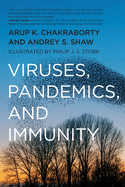
Never in recent times has the study of plagues and contagions--their presence and power--been more relevant than during the global Covid-19 crisis. Three renowned scientists--one of whom serves as illustrator--present an accessible, highly informative analysis of viruses and pandemics and their existential threat.
They offers a concise history of viruses. The Constantinople pandemic in 500 AD wiped out half of the European population. The great bubonic plague of the 14th century spread through China, the Middle East and Europe, killing roughly 100 million people. The 1918 influenza pandemic originally emerged as a seasonal flu that escalated to claim countless lives--similar flu-like occurrences also snowballed in 1957, 1968 and 2009. Outbreaks of cholera, smallpox, tuberculosis, measles, leprosy, malaria, HIV and Ebola have also contributed to widespread global death.
Through fascinating examples of scientists working behind the scenes, Chakraborty, Shaw and Stork explain--through an easy-to-follow narrative and well-rendered visuals--how viruses function and emerge to create epidemics. They examine how the human immune system responds and tries to combat viral invasions, and they offer further insights into the role of diagnostic tests, antiviral medications and vaccines.
The war against infectious disease and pandemics will continue. However, this fascinating, thoroughly researched book offers much hope. The authors stress how knowledge gained from pandemics--mapping the mutation of viruses and the determined, ongoing quest toward mitigation and eradication--will serve to make the world more "pandemic resistant" in the future. --Kathleen Gerard, blogger at Reading Between the Lines

